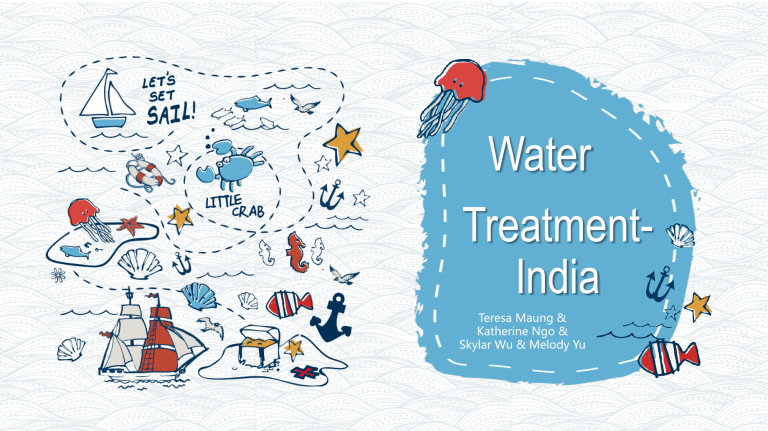
Water TreatmentIndia Teresa Maung & Katherine Ngo & Skylar Wu & Melody Yu C O N T E N T S Part One Part Two Water Crisis Benefits Part Three The Water Treatment Process Part One Water Crisis Part one Diarrohoeal Diseases Cholera Amoebiasis Giardiasis Bacillary Dysentery Part one Other Infections 01 Hepatitis A and E 02 Typ h o i d a n d P a r a t yp h o i d 03 Guinea Wo r m Infection Part one Statistics Annually about 37.7 million Indians are affected by waterborne diseases, Waterborne diseases such as continue to be prevalent in India and have caused 10,738 deaths, over the last five years since 2017. 1.5 million children die of diarrhea and 73 million working days are lost leading to an economic burden of $600 million a year. Part one Correlation The Delhi-based PEACE Institute Charitable Trust, which initiated the study to discover the correlation between the health of the Yamuna and the health of the community dependent on it over the last 25 years, unequivocally blames the Capital’s increasing illhealth on the river’s condition. It has based its findings on data collected largely from different state agencies. PartTwo Benefit Part two Energy Production 01 02 The sludge collected during the treatment is This energy can be used to treated with anaerobic bacteria. The gas power the wastewater treatment produced during this anaerobic process plants making them self- contains a large amount of methane, which is sustainable, and if there happens harvested and then burned to generate to be an excess of energy electricity. produced, it could be transported into a country’s national grid. 03 Part two Health Benefits Reduces the prevalence of Waterborne Diseases as transferred through direct consumption Waste Reduction - reduces the water loss induced through water pollution. - India lacks overall long-term availability of replenish-able water resources. Better the living environment of aquatic species and land species who rely on water safety Part Three Water Treatment Process Part three Part three Portable Water Treatment 1. Water Intake 2. Chemical addition of lime and alum to form “flock” (tiny sticky particles) to attract dirt particles 3. Coagulation & Flocculation: dirt & other particles attracted to flock 4. Sedimentation: allows flock materials to sink to bottom & be filtered out 5. Filtration: using sand, gravel, and/or charcoal layers 6. Disinfection: while stored in tanks, kills microbes, usually w/ Cl 7. Distribution Part three Primary Treatment Wastewater is passed through several tanks and filters that separate water from contaminants. The resulting “sludge” is then fed into a digester, in which further processing takes place. This primary batch of sludge contains nearly 50% of suspended solids within wastewater. Physically remove particles through filtration and sedimentation. 3. Remove sludge and scum. Sludge settles to bottom of sedimentation tanks. Scum (grease, oils, plastics, soaps) float. This removes all solids. Part three Primary Treatment 1.Screening: remove large objects 2. Aeration: Expose to air to release dissolved gases and replenish oxygen. Grit chamber. 4. Filtration for liquid sewage with gravity. 5. Disinfection with Cl 6. Effluent (Treated water) released to local river or ocean. Part three Use bacteria to remove contaminants. Secondary Treatment Removes more than 90% of suspended solids Part three Secondary Treatment 4.Large part pumped into large tanks, anaerobic sludge digesters, where anaerobic bacteria & fungi digest it. Usually produces methane, which is burned to fuel treatment facility. 2.Effluent passed into settling tank so bacterial “flocs” can sediment (activated sludge). 1.Primary effluent passed into aeration tanks and agitated mechanically. 3. Small part pumped back into aeration tank as inoculum. 5.Leftover sludge burned or buried in landfill. Fluid recycled. Part three Septic Tank System 1.Household sewage digested by anaerobic bacteria. 2.Solids settle to bottom as sludge. Oil & grease float to top as scum. Liquid effluent carried to drain field. Compartments & T-shaped outlet prevent sludge & scum from leaving tank. 3. Water seeps out through holes in tiles of drain field 4. Water percolates thru soil, which naturally removes coliform bacteria, viruses, nutrients. Part three Bibliography 1.Khambete, Aarti K. “When Water Kills.” India Water Portal, Arghyam Initiative, 9 Jan. 2019, www.indiawaterportal.org/articles/when-water-kills. 2.“Primary, Secondary, and Tertiary Wastewater Treatment: How Do They Work? - Innovative Solutions for Wastewater Treatment: Organica Water Inc.” Innovative Solutions for Wastewater Treatment | Organica Water Inc., 27 June 2017, www.organicawater.com/primary-secondary-tertiary-wastewater-treatment-work/ . 3.“Secondary Wastewater Treatment.” Secondary Wastewater Treatment | Northern Great Plains Water Consortium, University of North Dakota Energy & Environmental Research Center (UND EERC)., 1992, undeerc.org/Water/Decision-Support/Treatment-Technologies/SecondaryWastewater-Treatment.aspx. 4. “Conventional Septic System.” Environmental Protection Agency, Nov. 2008, www.epa.gov/sites/production/files/styles/large/public/201811/conventional_septic_system-600x575.jpg. THANK YOU



